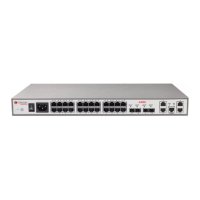A10E/A28E/A28F Configuration Guide
Figure 9-1 Working mechanism of SNMP
Orion NView NNM system can provide friendly Human Machine Interface (HMI) to facilitate
network management. The below functions can be realized through it:
Send request packets to the managed device.
Receive reply packets and Trap packets from the managed device, and show result.
Agent is a program stays in the managed device, realizing the below functions:
Receive/reply request packets from NView NNM system
Read/write packets and generate response packets according to the packets type, then
return the result to NView NNM system
Define trigger condition according to protocol modules, enter/exit from system or reboot
device when conditions are satisfied; reply module sends Trap packets to NView NNM
system via agent to report current status of device.
Agent can be configured with several versions. Agent use different versions to
communicate with different Nview NNM systems. However, SNMP version of the
NView NNM system must be consistent with the one on Agent when they are
communicating. Otherwise, they cannot communicate properly.
Protocol versions
Till now, SNMP has three versions: v1, v2c, and v3, described as below.
SNMP v1 uses community name authentication mechanism. The community name, a
string defined by an agent, acts like a secret. The network management system can visit
the agent only by specifying its community name correctly. If the community name
carried in a SNMP message is not accepted by the A10E/A28E, the message will be
dropped.
Compatible with SNMP v1, SNMP v2c also uses community name authentication
mechanism. SNMP V2c supports more operation types, data types, and error codes, and
thus better identifying errors.
SNMP v3 uses User-based Security Model (USM) and View-based Access Control
Model (VACM) security mechanism. You can configure whether USM authentication is
enabled and whether encryption is enabled to provide higher security. USM
authentication mechanism allows authenticated senders and prevents unauthenticated
senders. Encryption is to encrypt messages transmitted between the network
management system and agents, thus preventing interception.

